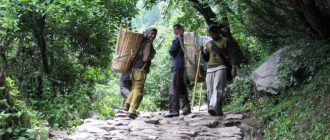Altitude sickness if a serious consideration if you are climbing or trekking in Nepal and it’s essential that you investigate the causes, symptoms and treatment of altitude sickness before you travel to Nepal.
There are approximately three deaths per year in Nepal from altitude sickness, but with the right precautions there is no reason why you should become one of these statistics.
Altitude Sickness, Nepal – What is Altitude Sickness?
Altitude sickness occurs when someone has been unable to acclimatise to the point to which they have ascended. As ascent increases, then levels of oxygen decrease. It is asserted that there is half the amount of oxygen at the Everest Base Camp as there is there is in the sea.
During ascents in Nepal an individual will typically find that their breathing increases to account for the decrease in oxygen. This is a positive response by the body and seems to be genetic as individuals who are more prone to altitude sickness typically manifest this response less readily than those who are less prone to altitude sickness.
Altitude sickness in Nepal (as elsewhere) happens when fluid collects in cells around the body as the result of failure to acclimatise. More severe forms of Altitude sickness occur when this fluid build up subsequently builds up in the lungs and brain – the two most susceptible parts of the body.
Altitude sickness, Nepal – what are the symptoms?
The symptoms of Altitude sickness in Nepal are nausea, irritability, headaches, a dry cough and in more severe cases of Altitude sickness the victim may start to cough up a pink frothy substance and lose their balance as though drunk.
Altitude sickness, Nepal – what is the prevention?
It is essential that you give your body time to acclimatise as you ascend. If you fly into high altitudes during your trip to Nepal, then you should spend two to three nights at that place enjoying the local attractions and resting.
This should give you time to acclimatise. You should take great note of your body at all times and if you feel the slightest of Altitude sickness symptoms then you should remain where you are until these have passed. As you ascend take frequent breaks at each 1000 meters and, again do not continue to ascend if you are feeling the slightest of Altitude sickness symptoms.
Altitude sickness, Nepal – what is the treatment?
If you are experiencing Altitude sickness during your trip to Nepal then it is essential that you ascend immediately and do not attempt to climb again until your body has acclimatised.
Severe cases may need to be flown out, so ensure that you have adequate travel insurance during your trip to Nepal.





